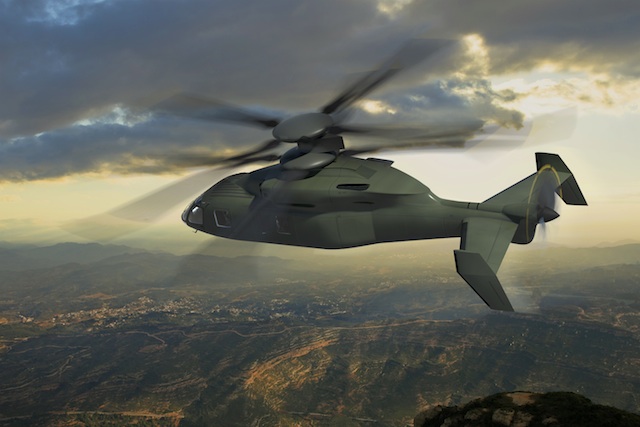Sikorsky and Boeing are weeks away from completing the final design review of their jointly developed high-speed SB-1 Defiant prototype as Swift Engineering works toward delivery of the core airframe this summer.
Conceived as a next-generation replacement for the UH-60 Black Hawk and AH-64 Apache, SB-1 is being pursued along with the Bell Helicopter V-280 for the US Army’s Joint Multi-Role (JMR) programme, which funds competing X-planes as a precursor to a Future Vertical Lift (FVL) acquisition.
Weighing in at 13.6t, SB-1 will have enough carrying capacity to transport four aircrew and 12 fully equipped troops in high, hot environments. Its pusher propeller will drive it to a top speed of 250kt.
In an interview at Boeing’s H-47 Chinook plant in Philadelphia last week, Boeing future vertical lift chief Pat Donnelly said most components of the rigid-rotor coaxial compound helicopter are already under construction and will start coming together later this year.
Donnelly says Swift Engineering of San Clemente, California will ship the core composite structure to Boeing's AH-64 Apache production plant in Mesa, Arizona by mid-year for design limit testing, before it continues east to Sikorsky’s rotorcraft facility in West Palm Beach, Florida in the September timeframe.
“The aircraft will be stuffed with all the hydraulics and mechanical components,” says Donnelly. “It’ll undergo final assembly and we’ll fly it down there.”

Boeing/Sikorsky
The aircraft cleared its preliminary design review (PDR) in 2014 and design engineers are now making tweaks ahead of locking down the final configuration as part of the critical design review.
There have been no major design changes since PDR, says Donnelly. “We’re going to roll right past it,” he says. “We have so many parts in the works right now that this is just a culmination and validation that this design is complete.”
In terms of building the actual structure, the Sikorsky-Boeing team appears to be lagging Bell, which took delivery of its V-280 composite fuselage from Spirit AeroSystems last year and is almost done assembling the wings and nacelles of its third-generation tiltrotor. The fuselage and the wings of the V-280 currently sit at opposite ends of Bell’s Amarillo, Texas plant where it completes assembly of the military AH-1Z, UH-1Y and V-22, as well as the commercial Bell 525.
However, Donnelly says SB-1 remains on track and will fly as planned in late 2017. “Team Defiant” has already established a fully functional systems integration laboratory and cockpit in Connecticut to test the software and flight controls and is beginning construction of the propulsion system test bed, or “Iron Bird”, at West Palm Beach.
“We anticipate having that running by the end of the year,” he says. “We’re starting to assemble that now and by fall we’ll start assembling the flight vehicle [for first flight in the third quarter of 2017].”
Future Vertical Lift-Medium is a new-start project in the army’s fiscal year 2017 budget submission and an acquisition plan will be considered by the Pentagon this October. SB-1 and V-280 are proof-of-concept demonstrators, but each side is continuously refining their ultimate FVL proposals as the technology as well as the army’s requirements and mission needs mature.
Source: FlightGlobal.com























